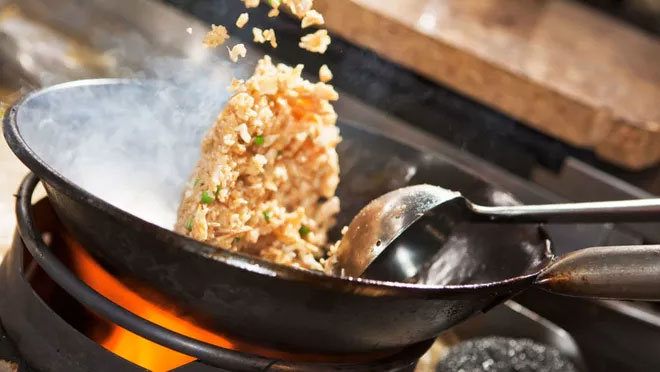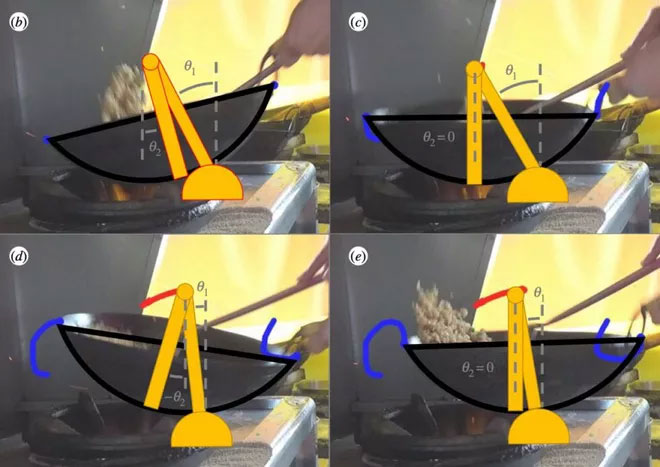Scientists have shown how to shake the pan to roast rice as best as possible
It is undeniable that fried rice is the source of life for many students, students and office workers. Certainly, the intimate fans of fried rice will have a familiar restaurant, but did you know that the hot and crispy fried rice dish is a perfect combination of chemistry and physics?
In a new study published in the middle of the month, scientists at the Georgia Institute of Technology created a dynamic model of a pan of roasted rice that was shaken on an open fire, hoping to understand how to roast rice enough. brown and not burnt.

Fried rice is a favorite food.
This is indeed a very interesting and useful study, not unlike the topics the group itself has done in the past: the laboratory of Professor David Hu from the Georgia Institute of Technology; They have studied the behavior of fire ants, water spiders (insects that can 'take care of the water'), snakes and mosquitoes, wrote down research on the characteristics of cat tongue and received a Nobel Ig 2019 about the study 'why wombat koales have cubes'.
Since spending time together studying the physics behind fire ants, Professor Hu and his student Hungtang Ko have discovered one thing in common, besides scientific research: these are the The physical aspect of making a dish, especially Asian fried rice, has been around for 1,500 years.
According to the author of the new study, shaking the pan on a hot stove is to make sure that the roasted rice has an eye-catching brown color, and that both the rice and food in the pan are not burnt. The process of roasting rice in a pan creates a 'Maillard reaction' : the chemical interaction between amino acids and carbohydrates placed in a high temperature environment, you can also see this reaction takes place as the meat is cooked and browning gradually.

How to shake a frying pan to make sure the brown rice is eye-catching and the food in the pan is not burnt.
Rice pans are not inherently gentle, and shaking pans can make a chef's arm tired; According to the survey, up to 64% of Chinese cooks say they suffer from chronic shoulder pain, in addition to many other illnesses. Researchers Hu and Ko want to understand that when they understand the physical factors behind the stirring pan, they will reduce the chef's shoulder injury.
In the summer of 2018 and 2019, the two researchers filmed the scene of five chefs working for Taiwanese and Chinese roast restaurants, and then relied on the footage to find out how often the pan was shaken. . On average, chefs take about 2 minutes to prepare a plate of roasted rice, and once roasting will require an average of 276 times shaking the pan, each shake lasts about ⅓ seconds.
They published preliminary research results at a 2018 meeting of the Department of Fluid Dynamics of the American Physics Council, and made their conclusions clear in their newly published scientific report. With only two variables, the team has successfully built a moving model of the pan; the pattern is similar to a double pendulum (one pendulum is attached to another underneath), because the cook rarely picks up the rice cooker from the tripod of the hot stove, but ' always keeps a contact point. let the pan slide back and forth . '


Their pan model predicted the flight path of the rice based on three factors: the proportion of the rice in the pan, how high the rice was, and how the angle was tilted.
According to the study, there are two separate stages of shaking the rice pan: pushing forward and turning the pan clockwise to catch the falling rice, and pulling the pan back and rotating it counterclockwise to toss. rice up.
Basically, the rice pan has two main movements: moving to the sides, and the seesaw movement when the left half is tilted high clockwise, and the right half tilted counterclockwise. ' The key point is to use a tripod on the stove as a fulcrum for the seesaw movement of the pan, ' the study authors noted. Another noteworthy point is that the pan movement is the same frequency, just a little bit off.
A chef must make sure that the rice is constantly leaving the hot pan to cool down slightly, because the pan can reach temperatures of 1,200 degrees C. It is the key to making brown rice eye-catching, not burnt.

Delicious fried rice dish, eye-catching.
Based on their analysis, the researchers Hu and Ko advised the chefs to increase the shaking of the pan, while increasing the interval between the two tosses and toppled the rice. ' This allows the rice to fly higher, causing it to mix more evenly and adding time for the rice to cool down, ' the researchers wrote.
The mathematical model involving rice cookers is not a study just to satisfy curiosity, this is also useful data for the robot design industry. One of the goals that the team of scientists wants to achieve is an exoskeleton skeleton to install on the cook, helping to reduce the rate of shoulder injuries for them.
For a long time, machines helped cookers perform odd (but crucial) tasks such as slicing onions, deep-frying oil, or turning cakes; There is no reason that roasted rice robots are not popular in Asia.
That said, the engineers who have been working on it have not come up with efficient rice roasting robots; There used to be an automatic pan that mimicked the chef's shaking, then defended to try to stir the rice like a real person, but the mixture of roasted rice was only mixed well, not flying in the air in a skillful way.
Could this new research change that?
- Test results: 'Thanh Den ancient rice' is modern rice
- China successfully researched 'sea rice', capable of raising 80 million people
- Super-sensitive, super-cheap earthquake detector
- Gene helps increase rice yield and quality
- Soft rice for the elderly
- 'Soft rice' ... helps solve hunger
- Discovering new rice varieties with antioxidant capacity
- Very simple way to cook rice without eating fat
- Looking for rice varieties
- Rice soaking overnight helps reduce the risk of toxic chemicals
- Journey of domesticated water rice
- Discovering rice varieties that are 'resistant' to climate change
 'Fine laughs' - Scary and painful torture in ancient times
'Fine laughs' - Scary and painful torture in ancient times The sequence of numbers 142857 of the Egyptian pyramids is known as the strangest number in the world - Why?
The sequence of numbers 142857 of the Egyptian pyramids is known as the strangest number in the world - Why? History of the iron
History of the iron What is alum?
What is alum?